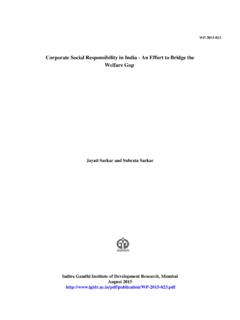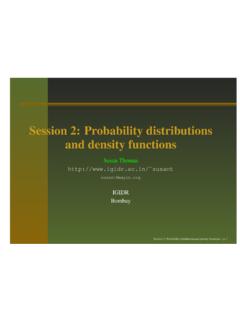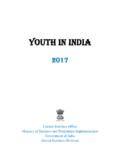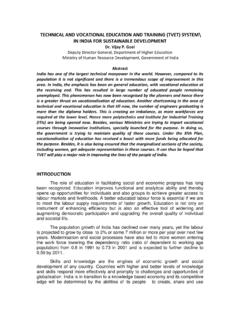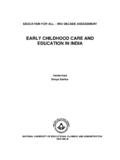Transcription of Internal Migration for Education and Employment …
1 WP-2014-004 Internal Migration for Education and Employment among youth inIndiaS Chandrasekhar, Ajay SharmaIndira Gandhi Institute of Development Research, MumbaiJanuary 2014 Migration for Education and Employment among youth inIndiaS Chandrasekhar, Ajay SharmaIndira Gandhi Institute of Development Research (IGIDR)General Arun Kumar Vaidya Marg Goregaon (E), Mumbai- 400065, INDIAE mail (corresponding author): paper sheds light on the issue of Internal Migration for Education and Employment among theyouth. those aged 15-32 years. The paper is a first step towards addressing the issue of whetherstates should be concerned about Internal brain drain since some states act as feeders and other statesgain at their expense. States with better job opportunities such as Delhi, Maharashtra, Gujarat,Karnataka are gainers whereas traditionally backward states of Bihar, Uttar Pradesh, Orissa,Rajasthan are losing human capital.
2 In the south, Kerala and Andhra Pradesh are possibly losing outworkers to Karnataka and Maharashtra. Keywords: Internal Migration , Education , Internal Brain DrainJEL Code: O15, R23 Acknowledgements:This paper is written as part of the initiative to Strengthen and Harmonize Research and Action on Migration in the Indian Context(SHRAMIC), supported by Sir Dorabji Tata Trust and Allied Trusts. SHRAMIC is anchored by IGIDR and is in collaborationwith CPR, NIUA, IRIS-KF and the Migration Program Partners of Tata Internal Migration for Education and Employment among youth in india 1. Introduction The perceived failure of india s Education policy to arrest dropout rates and deliver quality learning along the various stages of Education ladder is an empirical fact.
3 While india has steadily moved towards universal primary Education , the age specific attendance ratios need to be improved. The age specific attendance ratio is calculated by dividing the number of persons in a particular age-group currently attending educational institutions by the estimated population in the age-group 6-10 years and then multiplying the resultant number by 100. In fact in 2007-08, the age specific attendance ratios were as follows: 6-10 years - 88 percent, 11-13 years - 86 percent, 14-17 years - 64 percent, 18-24 years 18 percent and 25-29 years - 1 percent (Government of india 2010a). There are also considerable variations in the age specific attendance ratios across the states of india . Figure 1 provides a comparison in the age-specific attendance ratio in 1995-96 and 2007-08.
4 The least gains have been recorded among those in the age group 18-24 years from 10 to 15 percent in rural india and from 23 to 27 percent in urban india . In contrast to the age specific attendance ratios where we do not take into account which class or grade the individual is attending, the net attendance ratio is defined as the ratio of number of persons in the official age-group attending a particular class-group to the total number persons in the age-group. The net attendance ratio drops off sharply after class V and is only 8 percent among those pursuing post higher secondary Education (Table 1). A scenario where the net attendance ratio at higher levels of Education can be doubled would augur well for india s youth and hence for the prospects of the economy.
5 The fact that the East Asian countries managed to achieve a sustained high growth rate beginning the decade of sixties is often attributed to their singular focus on three outcomes, viz. improving educational attainment, increasing workforce participation rate and stepping up the higher investment rate. While india has a healthy savings rate of 34 percent and investment rate of 36 percent (Government of india 2011a) it still lags in improving the quality of human capital and increasing the workforce participation rate, and in particular that of women. There is evidence to suggest that educating and skilling india s youth by improving access to tertiary Education and increasing the completion rates have significant implications for the economy.
6 Castell -Climent and Mukhopadhyay (2010) conclude 2 that if one percent of the adult population were to complete tertiary Education instead of completing only primary school, the annual growth rate could increase by about 4 percentage points (p 4). They also find that a one percent change in tertiary Education has the same effect on growth as a 13 percent decrease in illiteracy. There is substantial scope for improving the net attendance ratio in india by focusing on the issue of dropout. From the survey data among the reasons given for discontinuation of studies include financial constraints, lack of interest in studies, unable to cope or failure in studies, and completed desired level or class (Government of india 2010).
7 Now consider a scenario where the reasons given for discontinuation can be addressed and individuals do not drop out and they go on to get a college degree. The question that arises is whether under this scenario india has sufficient number of seats in colleges and universities. The answer is no. Not surprisingly, many students are going abroad in pursuit of higher Education following which they do not necessarily return to india . The impact of brain drain on the growth prospects of the country loosing human capital is well documented. Unlike international brain drain, the phenomenon of Internal movement of human capital in search of Education is not that well analyzed although there is a large literature on Internal Migration in search of Employment .
8 The youth are likely to be attracted to Indian states or cities with high wages and a strong labour market. Institutes for higher Education are likely to be present in locations with high human capital and well functioning labour markets. Such effects are reinforced when individuals with higher level of Education move into these locations. Akin to the effects of international brain drain, when the youth migrate internally in search of Education and Employment there are winners and losers among the states and cities of india . This chapter describes the phenomenon of Migration by youth , those in the age group 15-32 years, in search of Education and Employment . 2. Data In india , there are two major sources of data on Migration : Census of india and surveys of National Sample Survey Organisation (NSSO).
9 Migration statistics based on Census of india 2011 have not been released as yet. The most recent information on Migration comes from NSSO s survey on Employment & unemployment and Migration conducted over July 2007-June 2008. This nationally 3 representative survey covered 79,091 rural and 46,487 urban households (Government of india 2010b). A total of 374,294 individuals in rural and 197,960 individuals in urban areas were surveyed. Information is available on households that moved their place of residence in the 365 days preceding the survey and individuals who migrated. Individual migrants are those whose last usual place of residence was different from the present place of enumeration. The usual place of residence is the village or town where the individual stayed continuously for a period of six months or more.
10 Specifically certain rates of migrations can be computed: out- Migration , short term or seasonal Migration , and return Migration . Broadly the reasons for Migration can be grouped into the following heads: Employment related, studies, forced Migration , marriage, and others. 3. Migration Patterns in india There are four Migration streams: rural-rural, rural-urban, urban-rural and urban-urban. Further, the stream can be intra-district, intra-state and inter-state. As is evident from Table 2 majority of the migrants move within the state, move within same districts or move to other districts of the same state. This is particularly true in the case of the rural-rural Migration stream. Figure 2 gives the distribution of migrants by age group.


